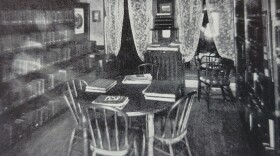Grandfather Falls. Historically known as Grandfather Bull Falls, is the largest water fall on the entire Wisconsin River, located just north of Merrill, dropping 90 feet in a mile. Before 1857, no logging had been done above this treacherous stretch water due to the perceived difficulty of floating logs through it. The main wagon road north also stopped there, preventing supplies from being brought overland to camps further into the Wisconsin River Valley.
With more people moving into the middle west of America, the demand for lumber was sky rocketing. Logging had been taking place south of Grandfather Falls for some 30 years before this time, and timber resources were becoming slim. Because of these reasons, logging companies began looking north once again, despite the challenges.
Fox and Helms Company of Stevens Point were the first to cut into the vast forests above Grandfather Falls. They selected a site at present day Eagle River because of the prominence of White and Red Pine timber situated on high banks around the chain of lakes, allowing for easy cutting and movement of logs into the waterways.
In the fall of 1857, a crew cut a tote road from Merrill, following the ancient footpath known as the Ontonagon Trail, running along the banks of the Wisconsin River up through the Fox and Helms camp at Eagle River, for the purpose of bringing supplies to the camp. Current Hwy 17 between Rhinelander and Eagle River would cover much of this early foot path and wagon trail. Logging was done over the winter with timber stacked along the banks of the Eagle River chain of lakes.
Nearing the 1st of May, 1858, the ice went out, allowing the first log drive north of Grandfather Bull Falls to begin. 15 men stayed on after the winter logging season to crew the drive. One of the men was a young John Curran, future pioneer of Rhinelander. Of the rest of the crew, many of men were French Canadians who had never done a river drive before. Luckily some loggers from Maine were in the crew and knew the work well. They also brought with them a special tool called a Peavey, known as the single greatest tool invented in logging up to that time. Much like a cant hook used for rolling logs, a Peavey had a spike on the far end. This may have been the first time such a tool was used in Wisconsin, it having been invented in Stillwater, Maine only a year before, and perfect for moving logs downriver.
The northern most logs positioned on the chain of lakes were rolled into the water. A large boom was built with a raft on each end positioned along shore so the drive crew could pole the boom downriver, thus collecting the logs floating in the lakes. They proceeded in this fashion through Eagle Lake, then Yellow Birch Lake, down the Eagle River, and finally into the Wisconsin River proper. The end of this journey was to be sawmills in Mosinee, some 100 Miles following the river as the crow flies, a tremendous distance. A route filled with wild waters, boulders, and rapids.
The water on the mighty Wisconsin was icy cold, and fast. Flowing with the current of a whole winter’s worth of snow melt. After several days working to get the logs into the river, the crew had a series of hang ups which included a strike over the number of meals it was receiving per day, and later with log jams between Eagle River and the Pelican Rapids, future site of Rhinelander.
Tragedy would strike the drive several days out, underscoring the dangerousness of the work. A young man named Ramuel DeJardine was discovered missing along the river. The men went to the last place he was seen maneuvering logs through the water and were able to recover his pike pole, meaning he was most likely in the water as well.
John Curran fashioned a hook on a long pole and proceeded to drag a nearby eddy he presumed the body would go to. After several attempts, the young man was hooked and brought to shore.
The somber crew decided the body was to be bought to Wausau where the young mans family was living. John was chosen to take the deceased downriver by boat, a big responsibility for a young man of 19. He chose 3 other crew members and they dragged a boat over the logs, and then followed with the body, placing him inside to make the journey. Nearing the place the tote road met the River at the confluence of the Pelican and Wisconsin River, the young man’s body had begun to decompose, and so John proposed they inter the man near the river. But the crew insisted they continue. Reaching Merrill, Ramuel was placed in a canoe whereby John took him the rest of the way to Wausau.
As Curran returned up river, he found the crew battered and beaten, having dealt with more jams at Pelican Rapids and the drive abandoned there. The crew then quit the drive and left for Stevens Point. While in Stevens Point, it began to rain across the north country, thereby raising the river level. John returned to the jam with a new crew, and was able to bring the logs the rest of the way over Grandfather Bull Falls without incident, the first crew to attempt it, and on to Mosinee.
This ended the first river drive above Grandfather Bull Falls, with much difficulty. It would not be the last drive on the Wisconsin to involve log jams, poor conditions, and death. Despite the risk, it would be the most efficient way to move logs out of the north country, until such a time in decades later when railroads were built.
Source: The Curran Story (Biography) by Joe Botsford 1953









